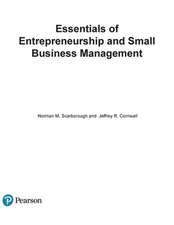Entrepreneurship in CentralEast Europe: Conditions · Opportunities · Strategies
Autor Jana Sereghyovaen Limba Engleză Paperback – 29 noi 1993
Preț: 640.24 lei
Preț vechi: 753.22 lei
-15% Nou
Puncte Express: 960
Preț estimativ în valută:
122.55€ • 133.16$ • 103.01£
122.55€ • 133.16$ • 103.01£
Carte tipărită la comandă
Livrare economică 21 aprilie-05 mai
Preluare comenzi: 021 569.72.76
Specificații
ISBN-13: 9783790807301
ISBN-10: 3790807303
Pagini: 292
Ilustrații: XII, 279 p.
Dimensiuni: 155 x 235 x 15 mm
Greutate: 0.41 kg
Ediția:Softcover reprint of the original 1st ed. 1993
Editura: Physica-Verlag HD
Colecția Physica
Locul publicării:Heidelberg, Germany
ISBN-10: 3790807303
Pagini: 292
Ilustrații: XII, 279 p.
Dimensiuni: 155 x 235 x 15 mm
Greutate: 0.41 kg
Ediția:Softcover reprint of the original 1st ed. 1993
Editura: Physica-Verlag HD
Colecția Physica
Locul publicării:Heidelberg, Germany
Public țintă
ResearchCuprins
1 Changes in Entrepreneurial Structures in CentralEast European Countries.- 1.1 Initial Structural Distortions.- 1.2 Changes in the Structure of the Enterprise Sphere in Hungary.- 1.3 Changes in the Structure of the Enterprise Sphere in Poland.- 1.4 Changes in the Structure of the Enterprise Sphere in the Former CSFR.- 2 Mainstays of the Institutional Framework for Entrepreneurial Activities Established in Individual CentralEast European Countries.- 2.1 The Formation of a Two-Tier Banking System.- 2.2 The Legal and Institutional Framework for the Formation of a Capital Market.- 2.3 Institutional Changes in Foreign Trade of CentralEast European Countries.- 3 The Main Features of the Trade-Political Framework in CentralEast European Countries.- 3.1 The Reasons for the Collapse of COMECON Trade and its Consequences for Enterprises in CentralEast European Countries.- 3.2 The First Steps Towards Granting CentralEast European Countries Access to Western Markets.- 3.3 Some Trade-Political Aspects of the Association Agreements Concluded between Individual CentralEast European Countries and the EC.- 3.4 Possibilities for a New Take-Up of Trade Between the Countries of CentralEast and East Europe.- 4 New Behavioural Patterns Emerging in the Enterprise Sphere of CentralEast European Countries.- 4.1 Changes in Behavioural Patterns in Agriculture and in the Food Processing Industry.- 4.2 Changes in Behavioural Patterns in Manufacturing (other than Food Processing).- 4.3 Changes in Behavioural Patterns in the Heavy Industry.- 4.4 Changes in Behavioural Patterns in the Service Sector.- 5 Entrepreneurial Opportunities in CentralEast European Countries for Foreign Investors and Businessmen.- 5.1 Identifying Entrepreneurial Opportunities in CentralEast European Countries.- 5.2 The“Stake-Holders” and Their Influence on Decision Making Processes Concerning the Choice of Foreign Partners.- 5.3 Risks and Risk Reducing Measures.- 6 Entrepreneurial Concepts Applied in Preparation for Becoming Part of a “Big Europe”.- 6.1 Entrepreneurial Strategies Developed in the CSFR.- 6.2 Entrepreneurial Strategies Applied in Catalonia — Spain.- 7 Indicators of the Eligibility of an Enterprise as a Base for a Potentially Successful Joint Venture.- 7.1 Available Data and Their Credibility.- 7.2 Methodology and Outcome of Comparing Past and Present Performance of Industrial Enterprises.- 7.3 Testing the Eligibility of Enterprises as a Base for a Potentially Successful Joint Venture.- Concluding Remarks.- References.
















